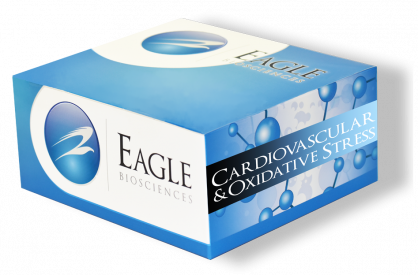Apolipoprotein CIII ELISA Assay
The Apolipoprotein CIII ELISA Assay is For Research Use Only
Size: 1×96 wells
Sensitivity: 50 pg/ml
Dynamic Range: 31.3-2000 pg/ml
Incubation Time: 4.5 hours
Sample Type: Serum, Plasma, or other biological fluids
Sample Size: 100 µL
Alternative Names: Human ApoCIII
SAMPLE COLLECTION & STORAGE INFORMATION
The sample collection and storage conditions listed below are intended as general guidelines. Sample stability has not been evaluated.
Serum- Use a serum separator tube (SST) and allow samples to clot for few minutes before centrifugation for 10 minutes at 1000 x g at 4°C. Collect serum and assay immediately or aliquot and store samples at -80°C up to 3 months. Avoid repeated freeze-thaw cycles.
Plasma – Collect plasma using EDTA or heparin as an anticoagulant at 4°C. Centrifuge for 10 minutes at 1000 x g at 4°C within 30 minutes of collection. Assay immediately or aliquot and store samples at-80°C up to 3 months. Avoid repeated freeze-thaw cycles.
Other Biological Fluids – Centrifuge samples for 10 minutes at 1000 g at 4°C. Assay immediately or aliquot and store samples at-80°C up to 3 months. Avoid repeated freeze-thaw cycles.
Assay Background
Apolipoprotein CIII (ApoCIII) is a very low density lipoprotein (VLDL) protein. APOC3 inhibits lipoprotein lipase and hepatic lipase; it is thought to delay catabolism of triglyceride-rich particles. The APOA1, APOC3 and APOA4 genes are closely linked in both rat and human genomes. The A-I and A-IV genes are transcribed from the same strand, while the A-1 and C-III genes are convergently transcribed. An increase in apoC-III levels induces the development of hypertriglyceridemia. [provided by RefSeq, Jul 2008] Apolipoprotein CIII (ApoCIII) is a component of triglyceride-rich very low density lipoproteins (VLDL) and high density lipoproteins (HDL) in plasma. Plays a multifaceted role in triglyceride homeostasis. Intracellularly, promotes hepatic very low density lipoprotein 1 (VLDL1) assembly and secretion; extracellularly, attenuates hydrolysis and clearance of triglyceride-rich lipoproteins (TRLs). Impairs the lipolysis of TRLs by inhibiting lipoprotein lipase and the hepatic uptake of TRLs by remnant receptors.
Related Products
Apolipoprotein CI ELISA Assay
Apolipoprotein CII ELISA Assay
Apolipoprotien E ELISA Assay Kit
Assay Principle
This assay employs the quantitative sandwich enzyme immunoassay technique. An antibody specific for ApoCIII has been pre-coated onto a microtiter plate. Standards or samples are pipetted into the wells and any ApoCIII present is bound by the immobilized antibody. After washing away any unbound substances, a biotin-conjugated antibody specific for ApoCIII is added to each well and incubate. Following a washing to remove unbound substances, streptavidin conjugated to Horseradish Peroxidase (HRP) is added to each microplate well and incubated. After washing away any unbound antibodyenzyme reagent, a substrate solution (TMB) is added to the wells and color develops in proportion to the amount of ApoCIII bound in the initial step. The color development is stopped by the addition of acid and the intensity of the color is measured at a wavelength of 450nm ±2nm. The concentration of ApoCIII in the sample is then determined by comparing the O.D of samples to the standard curve.
Assay Procedure
1. Remove excess microtiter strips from the plate frame, return them to the foil pouch containing the desiccant pack, and reseal it. Standards and samples should be assayed in duplicates.
2. Add 100 μl of the Standards and diluted samples into the appropriate wells. Incubate for at least 2 hours at 37°C or incubate overnight at 4°C on a microplate shaker.
3. Aspirate each well and wash, repeating the process 2 times for a total 3 washes. Wash by filling each well with 1× Wash Buffer (250 μl) using a squirt bottle, manifold dispenser, or autowasher. Complete removal of liquid at each is essential to good performance. After the last wash, remove any remaining Wash Buffer by aspirating, decanting or blotting
4. Add 100 µl of the 1:1000 diluted Conjugated-ApoCIII antibody working solution to each well, incubate for 1 hour at RT on a microplate shaker.
5. Aspirate each well and wash as step 3.
6. Add 100 µl of the diluted HRP-Streptavidin working solution to all wells and incubate for 1 hour at RT on a microplate shaker.
7. Warm TMB substrate solution to RT before next wash step. Aspirate each well and wash as step 3. Proceed immediately to the next step.
8. Add 100 μl of TMB substrate solution into each well. Incubate for 2-30 mins at RT on microplate shaker. Avoid exposure to light. Note: Watch plate carefully; if color changes rapidly, the reaction may need to be stopped sooner to prevent saturation.
9. Add 100 μl of Stop Solution to each well and shake lightly to ensure homogeneous mixing.
10. Read the OD with a microplate reader at 450nm immediately (optional: read at 620 nm as reference wave length).
Package Inserts
Please note: All documents above are for reference use only and should not be used in place of the documents included with this physical product. If digital copies are needed, please contact us.


